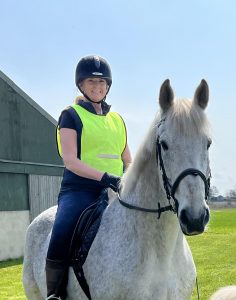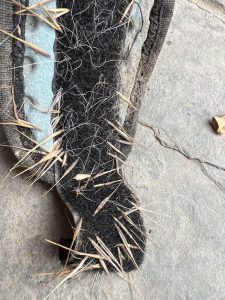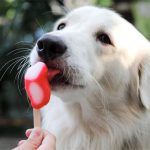⚠️GRASS SEED Season Is Upon Us! ⚠️ Warning – Dogs And Grass Seeds.
Now that summer has finally arrived, we can enjoy walking our dogs in the glorious sunshine out in the countryside. However, it is important to be aware of areas which could pose a danger to our dogs. Read our Holidays4Dogs article for more information on grass seeds and dogs.
Grass seeds, especially barley grass are sharp enough to penetrate the skin and migrate around the body. It is also common for them to become stuck in the nasal cavity. The risks that grass seeds pose to dogs, are significantly increased in the summer months.
Risks.
It is most common for grass seeds to lodge between the toes, but equally they can get into the ears, nose and eyes causing hay-fever symptoms. They can also cause problems in the external reproductive organs.
Seeds between the toes can develop into cysts if not removed and your dog will show signs of discomfort by licking or biting between the toes. Grass seeds lodged in the paw area may also cause the dog to limp.
Likewise, if a seed has become lodged in the ear canal, your dog may shake his head or scratch his ears frantically. Because dogs sniff the ground, seeds easily become lodged in the nasal cavity and can even work their way into the lungs.
Therefore, it is always good practice to check your dog for grass seeds after each walk and preferably avoid areas of long grass or barley crops altogether over the summer season.
What to do if your dog is affected by grass seeds.
Once a seed has become lodged under the dogs’ skin, or in the eye, or ear, you will need to take your dog to the vet promptly. It is vital the seed is removed, to prevent further infection. Your vet may also prescribe antibiotics.
To reduce the risk of grass seeds harming your dog there are a number of tips you can consider;
Avoid walking your dog through large open areas of long grass, or crops. Although it is fun for dogs to run around in fields and paddocks, it can quickly become a source of misery should the dog pick up a grass seed.
Always groom your dog after walking near long grass, especially long-coated breeds. Check for grass seeds between the toes of your dog. Also, check inside the ears and eyes, as well as under the tail and “armpits”.
If your dog has a heavy coat you may want to consider clipping the long fur from between the toes and around the hocks. Any dog groomer will do this for you if feel you cannot tackle it yourself.
 Out riding this weekend I took a short-cut across a field to avoid getting caught in thunder. This seemed like a good idea (and I did miss the storm).
Out riding this weekend I took a short-cut across a field to avoid getting caught in thunder. This seemed like a good idea (and I did miss the storm).
But, I was soon alarmed to see the number of nasty barley grass under the hoof. Long grasses brushing past my horses legs, made me very worried they’d get stuck in his legs and, at the very least, to my horses boots – which did happen.
ALARM! Imagine these seeds under your dogs skin?! Thankfully, my horse was unaffected, but he had a good groom just the same.
(Any tips how to get rid of them from horse boots, without painstakingly picking them, out would be most welcome!)
A personal lesson learned.
This experience reminded me of an event that happened many years ago (17 years to be exact) and which will stick in my mind forever. I was looking after a regular guest Beagle and while we were out walking, he suddenly started sneezing.
He continued intermittently sneezing and occasionally rubbing his nose, even after we got back home. Despite seeing nothing up his nose, I highly suspected it was a grass seed. This was not to be ignored!
Surgery.
A vet examination of the dog’s nose revealed nothing except a tiny ‘whispy end’ of a grass seed, buried very deep inside the nostril. It was essential this was removed straight away and, to do this, the dog had to be anaesthetised.
Even the vet was shocked by the size of the large barbed seed (3cm +) which was, thankfully, removed safely.
Thank goodness, my quick action of getting the dog to the vet meant the seed didn’t migrate any deeper. Any delay and the grass seed would have embedded even further into the nasal cavity.
This would have most likely resulted in evasive surgery to remove the seed via the side of the dog’s face.
Really nasty…
I have seen some dreadful situations of seeds lodged between the toes of dogs. However, they can also get into the ears, nose and eyes, as well as the external reproductive organs.
Grass seeds between the toes can rapidly develop into cysts if not removed and your dog will show signs of discomfort by licking, or biting, between the toes.
Likewise, if a seed has become lodged in the ear canal, your dog may shake his head or scratch his ears frantically. Because dogs sniff the ground, seeds easily become lodged in the nasal cavity and can even work their way into the lungs.
It it is always a sensible precaution to keep dogs out of long grass when walking in the countryside, to avoid this really nasty situation.
Conclusion.
 Make sure you are familiar with the places where you will be walking your dog. Be aware of your local environment and when grass seeds are likely to be most prevalent. Avoid these areas as far as possible when out with your dog.
Make sure you are familiar with the places where you will be walking your dog. Be aware of your local environment and when grass seeds are likely to be most prevalent. Avoid these areas as far as possible when out with your dog.
There are plenty of less hazardous areas to walk your dog which can still be fun for them. While a dog can look very amusing, or photogenic, bouncing through long grass – there are very real hidden dangers. All our Holidays4Dogs carers are well aware of grass seed danger and will, therefore, minimise contact when guest dogs are staying.
It may look fun but, PLEASE DO NOT let your dog run around in long dry grass. Ears, eyes, noses, skin and doggie ‘privates’ can all be affected. Grass seeds and dogs don’t mix.



